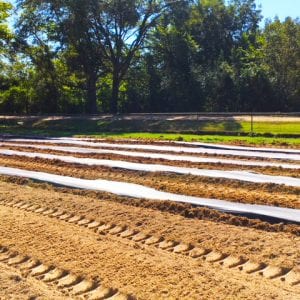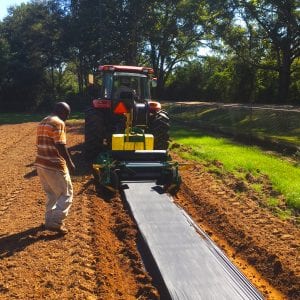Crop Production

Learn the benefits and drawbacks of using plastic mulch, how to use it, and what plastic mulch products are available.
The use of plastic polyethylene mulch in fruit and vegetable production is a common practice in Alabama. Among the crops for which it’s used are strawberry, watermelon, muskmelon, tomato, pepper, cucumber, squash, and brassicas such as collards, broccoli, and cabbage. Successful application requires an understanding of (a) how to use plastic mulch, (b) what the benefits and drawbacks of its use are, and (c) what types of plastic mulch products are available.
Application and Cultural Systems
The most widely used and economical plastic mulches are embossed black polyethylene films with irrigation drip tape installed under the mulch (Figure 1). Mulch is usually applied by a tractor-drawn mulch layer implement, which lays the plastic and drip tape into beds while anchoring the edges with soil (Figure 2). It is important that soil is well prepared before laying the plastic mulch to ensure a tight fit between mulch and soil. Any clumps of grass, sod, weeds, or soil make proper application difficult. All chemicals and most fertilizers should be applied during bed preparation. The remaining fertilizer can be applied throughout the growing season as a soluble liquid added through the drip irrigation system using a fertilizer injector. Supplying fertilizer through the drip irrigation system is crucial in sandy soils where any initial fertilizer is likely to leach away from the plant root zone. Management of weed growth in the alleys between mulch beds is important. Tactics for controlling these weeds include mowing, cultivating, using organic mulch, cover cropping, or using herbicides approved for row middles. Weeds that emerge in planting holes in the mulch should be removed by hand early. This especially applies to vining weed species such as morning glories and bindweeds. Plastic mulch can be double cropped, meaning a second crop can be grown on the mulch after the first is harvested. Fertilization for the second crop should be applied through the drip irrigation system.
- Figure 1. Embossed black polyethylene film with irrigation drip tape installed under the mulch.
- Figure 2. This tractor-drawn mulch layer implement lays the plastic and drip tape into beds while anchoring the edges with soil.
Benefits and Drawbacks
There are many benefits to growing vegetables on black plastic mulch:
- Soil temperature in the bed is increased, allowing for faster development and earlier crop yields in spring and early summer.
- Weed growth around crops is inhibited.
- Crops are kept clean.
- Fungal disease is prevented through reduced soil splashing.
- Soil moisture is better retained.
- Soil compaction is prevented.
- Erosion and leaching is reduced.
Disposal of plastic mulches is among the biggest challenges of this technology. Removal from fields is time-consuming and expensive. Polyethylene plastic is not biodegradable and not readily recyclable. As such, most plastic mulch is either disposed of in landfills or stockpiled. Mulch removal at the end of the season is required for certified organic growers. Beyond the challenge of disposal, the major drawback to plastic mulch systems is the initial cost of specialized equipment, including a mulch applicator, the mulch and drip tape, a transplanter, and a fertilizer injector.
Plastic Mulch Products
The most common plastic mulches used are plain or embossed black polyethylene films between 0.8 and 1.25 millimeters thick and 4 feet wide. Black mulch will raise soil temperatures from 3 to 5 degrees F. Black plastic is the least expensive option, but different mulch products can provide other properties:
Clear Plastic Mulch
These mulches transmit solar radiation to the soil and block the radiation from escaping. This creates a mini-greenhouse under the mulch. Soil temperatures can be 8 to 14 degrees F higher while using this mulch. The downside is that clear plastic mulches allow light to penetrate, which promotes weed germination and growth. Weeds eventually tear the plastic and compete with the crop. Clear plastic mulches are not recommended in Alabama due to weed issues. They can be useful, however, if applied during hot weather as a way to solarize soil and kill plant pathogens and some weed seeds.
White Plastic Mulch
These mulches reflect incoming solar radiation. Soil underneath white plastic will therefore be cooler compared to bare soil. White or white-on-black mulch is commonly used for fall crops when soil is already warm during establishment and black plastic has the potential to overheat plant roots.
Silver/Metallic Plastic Mulch
Research has shown that silver mulches confuse and repel plant pests, such as aphids and flower thrips. This product can be useful when growing peppers or tomatoes, as thrips are the main vector for tomato spotted wilt virus. Silver mulch also encourages early fruit ripening by reflecting light back to the canopy. Soil under silver plastic will be several degrees cooler than soil under black plastic. Infrared-Transmitting (IRT) Plastic Mulch These films absorb certain colored wavelengths but transmit heat (infrared) radiation to the soil. The materials heat soil as efficiently as clear mulches but reduce the weed germination issues.
Colored Plastic Mulch
Red, blue, orange, and yellow mulches produce distinct radiation that reflects into the crop canopy. Research into colored mulches has shown inconsistent results, however, and they are not widely used in Alabama.
Biodegradable Mulch
These mulches were developed in response to removal concerns of plastic mulches. They are designed to be tilled into the field and break down over time in the soil. The products can perform as well as polyethylene mulches in heating soil and preventing weeds, but they cost significantly more. None of these products currently meet National Organic Program (NOP) standards for use in certified organic systems.
Download a PDF of Plastic Mulch for Vegetable Production, ANR-2534



